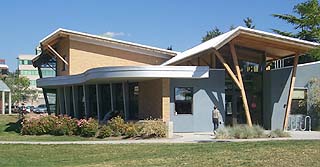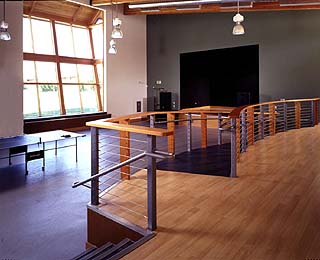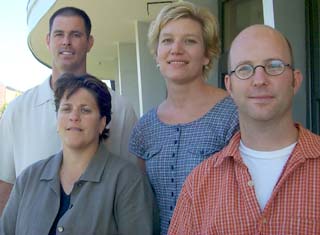|
Subscribe / Renew |
|
|
Contact Us |
|
| ► Subscribe to our Free Weekly Newsletter | |
| home | Welcome, sign in or click here to subscribe. | login |
Construction
| |
August 7, 2002
A retreat for teens ends decade-long run-around
Special to the Journal

Photo by Clair Enlow The Kirkland Teen Union Building presents an eclectic face to the park. The architect joined the new building with an existing senior center, but gave the teen center a free play of square corners and curves, sloping and flat roof planes. |
The new teen center in Peter Kirk Park is somewhat unpredictable, a little cheeky. It’s easy to compare it to the parents-eye-view of the typical teen, a kid who wants to be taken seriously but refuses to be serious.
That may be because teens were involved in the project from the very beginning, getting it off the ground, pushing it through the political process, selecting the designers and providing input for the program and the personality.
"It was so different than working with a typical building committee," said Stig Carlson of Lewis Architecture, designer of the Kirkland Teen Union Building. Members of the Kirkland Youth Council were there all the way, attending the design meetings and helping to present the concept to the city council.
|
Kirkland Teen Union Building 348 Kirkland Avenue |
|
Owner
City of Kirkland Architect Lewis Architecture + Interior Design Ross Jameson, principal in charge, John Cannon, supporting principal, Stig Carlson, project architect, Kim Parsley, interior designer, Anna Lovell, interior designer. Completion date June 2001 Project type Community service facility Construction type Wood frame with masonry and stucco exterior Project size 6,000 square feet (new construction) 700 square feet (remodel) Construction cost $1.1 million Civil engineer Layton & Sell Structural engineer Hudson & Associates Mechanical engineer Weland Lindgren Electrical engineer McGowan Broz Cost estimator The Robinson Company General contractor M.J. Shockley Construction Jury comments: This project is a terrific step
in the evolution of teen centers away from their institutional origins.
|
But the history of the project goes way back. By his account, Justin Hurst and his friends grew up with the project. "It was a sketch on a napkin when we were 13," said Hurst, now 20 and an information technology director for Taylor Construction.
Teens were hanging out in downtown Kirkland. "There was a definite lack of places to go," said Hurst. "The business community was getting fed up."
They tended to congregate at coffee and espresso places, exasperating owners with long stays and low spending. In the beginning, the idea of the new teen center was to take over an existing building, making it over with a coffee house atmosphere and packing in a few amenities for recreation and arts pursuits. But the first attempts at settling on a site turned into more battles with local business people, potential neighbors who were convinced that a teen center opening next door would push them to the brink of bankruptcy.
In the meantime, Hurst had become a charter member of the Youth City Council, an advisory group to the Kirkland City Council. The No. 1 item on the new group’s agenda was the creation of a teen center. They had seen enviable facilities created in Redmond and Bellevue, and wanted one of their own. The essentials that eventually made it into the final program for the Kirkland facility include a highly visible and inviting coffee shop and comfortable indoor and outdoor seating areas. The teen center also has a dance floor, a stage, a sound studio, computer room, media room and even an art classroom.
With a wish list of features that could not easily be packed into an existing building and history of contention between teen activists and the business community, the city council finally settled on construction of a new building in Peter Kirk Park. The idea of siting it right next an existing senior center and taking up precious green space weighed heavily on the decision, but these were problems that could be solved, politically and architecturally.
Lewis Architecture solved both problems by joining the teen center with the senior center. The two facilities share some of their uses (such as the pool room in the senior center and the computer center in the teen center) and park encroachment is kept to a minimum. Facing the park, the complex, curving lines of the building as it faces the park roll with the topography of the green space, softening and enriching the edge.
Teens on the Youth City Council helped to choose the team, clearly hoping they would produce something a little surprising to park visitors.
"They didn’t want just another public building," said Carlson. "They wanted some place dynamic."
The architect’s response is a free play of square corners and curves, sloping and flat roof planes. From the high walls of the central section -- with its steep, bracketed roof -- the low metal edging of a flat roof snakes around the corner of the building like a diner counter.

Photo by Patrick Barta The stage was built with a grant from Aaron and Rachel Contorer. |
The design is based on a simple strategy -- a central circulation path divides the building, with support spaces and enclosed areas on one side and larger, open areas on the other. Along the spine, independent massing of major components of the building give the teen center eye-catching energy on the outside and a series of exciting spaces inside. With a central, shed-roofed section that pops up over it all, there are plenty of opportunities to bring in surrounding scenery and natural light.
It’s a strategy that has worked before in suburban settings, most notably at Woodinville City Hall, also by Lewis Architecture.
Inside, the coffee house is reinvented as a teen-friendly environment. A counter that flanks the front entrance is run by teens, who serve snacks, quenchers, and ice creams. They can survey the park and most of the center from their post, thanks to the outside window and the largely open plan. Administrative and support services anchor the center from the other side of the entry.
From the door, visitors can assess the ambiance in the seating area by the café. They can also survey the stepped-down dance floor that faces the concert stage, and wide circulation spine that extends to the art classroom and recording studio in the back. In between, there is a darkroom facility just behind the administrative area, an enclosed media lounge opposite the dance floor. The stage and sound studio was built with a grant from Aaron and Rachel Contorer and equipment donated by Mackie Sound Design of Woodinville.
Architectural details and colors help to carry the mood of the teen center, evoking the feeling of a hip workplace or upscale coffee joint.

Photo by Clair Enlow Interior designer Kim Parsley and architect Stig Carlson with community services manager Carrie Hite and center director Cory Shepard |
The sheer volume of visitors looks good, according to center director Cory Shepard. The center gets about 800 visits per month, and many of those are from kids who return again and again. That does not count attendance at the many special events -- concerts, dances, classes -- at the center. But the architecture is only part of the draw. Shepard reaches out to schools and other youth-centered settings to promote the programs at the teen center and to do field research on why kids may not be using the center and what they would like to see there.
And while much of the original resistance to the facility came from downtown business owners, the support within the business community of Kirkland is now overwhelming, according to city community services manager Carrie Hite. Business organizations support programs, and local business owner Jim Lauinger, now a city council member, took out a full page ad in the local paper welcoming the center.
Although Justin Hurst and his friends have moved on to adulthood, teens in Kirkland have a few more options than they did before. At the center, kids can be found in groups of two and three throughout the center. In addition to the crew managing the café, they sit behind desks in the administrative area, lounge on plush sofas in the media center, lean on the rail along the edge of the dance floor, and work over the controls of the sound lab. It’s all part of the plan. But for these kids, its a free choice on a summer day.
Clair Enlow can be reached by e-mail at clair@clairenlow.com.
Previous columns:
- A once lackluster hall now scans the heavens, 07-03-2002
- Design team got a workout at Hec Ed, 06-05-2002
- A terra cotta shell for intimate dining, 05-01-2002
- Serious, modern City Hall, with a friendly barn door, 04-03-2002
- Tiny Mercer Island chapel solves a small, tricky problem, 03-06-2002
- Temporary library makes a lasting impression, 02-06-2002
- Signature identity on a human scale, 01-09-2002
- Gates Hall uses the past to create a better future, 12-05-2001


